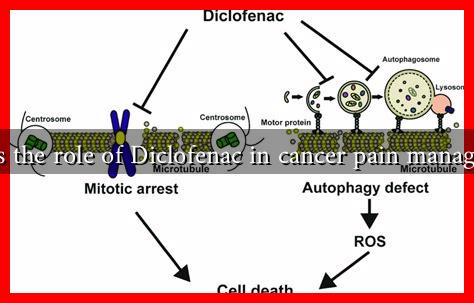-
Table of Contents
What is the Role of Diclofenac in Cancer Pain Management?
Cancer pain is a complex and multifaceted issue that affects a significant number of patients undergoing treatment for various types of cancer. Managing this pain effectively is crucial for improving the quality of life for these patients. Among the various analgesics available, Diclofenac, a non-steroidal anti-inflammatory drug (NSAID), has emerged as a potential option for alleviating cancer-related pain. This article explores the role of Diclofenac in cancer pain management, its mechanisms of action, benefits, and considerations for use.
Understanding Cancer Pain
Cancer pain can arise from several sources, including:
- The tumor itself, which may invade surrounding tissues and organs.
- Side effects from cancer treatments such as chemotherapy, radiation, and surgery.
- Psychological factors, including anxiety and depression, which can exacerbate pain perception.
According to the American Cancer Society, approximately 30% to 50% of patients undergoing active treatment experience significant pain, and this figure can rise to 70% to 90% in advanced stages of the disease. Effective pain management is essential not only for comfort but also for enabling patients to engage in their treatment plans and maintain a better quality of life.
Diclofenac: An Overview
Diclofenac is a widely used NSAID that works by inhibiting the production of prostaglandins, chemicals in the body that promote inflammation, pain, and fever. It is available in various forms, including oral tablets, topical gels, and injections. Its anti-inflammatory properties make it a suitable candidate for managing pain associated with cancer.
Mechanisms of Action
The primary mechanism of Diclofenac involves the inhibition of cyclooxygenase (COX) enzymes, particularly COX-2, which are responsible for the synthesis of prostaglandins. By reducing the levels of these inflammatory mediators, Diclofenac can help alleviate pain and inflammation associated with cancer. Additionally, some studies suggest that Diclofenac may have direct antitumor effects, although this area requires further research.
Benefits of Diclofenac in Cancer Pain Management
Diclofenac offers several advantages in the context of cancer pain management:
- Effective Pain Relief: Clinical studies have shown that Diclofenac can significantly reduce pain levels in cancer patients, particularly those experiencing bone pain or pain from soft tissue tumors.
- Reduced Need for Opioids: By effectively managing pain, Diclofenac may reduce the reliance on opioids, which are associated with numerous side effects and the risk of addiction.
- Multiple Administration Routes: The availability of Diclofenac in various forms allows for tailored pain management strategies based on individual patient needs.
Case Studies and Evidence
Several studies have highlighted the efficacy of Diclofenac in managing cancer pain:
- A study published in the Journal of Pain and Symptom Management found that patients receiving Diclofenac reported a significant reduction in pain scores compared to those on placebo.
- Another clinical trial demonstrated that Diclofenac, when used in conjunction with opioids, provided superior pain relief without increasing the incidence of adverse effects.
Considerations and Side Effects
While Diclofenac can be an effective option for managing cancer pain, it is not without risks. Potential side effects include:
- Gastrointestinal issues, such as ulcers and bleeding.
- Cardiovascular risks, particularly in patients with pre-existing heart conditions.
- Kidney damage with prolonged use.
It is essential for healthcare providers to assess the risks and benefits of Diclofenac on a case-by-case basis, considering the patient’s overall health status and treatment goals.
Conclusion
Diclofenac plays a significant role in the management of cancer pain, offering effective relief while potentially reducing the need for opioids. Its anti-inflammatory properties and various administration routes make it a versatile option for healthcare providers. However, careful consideration of its side effects and contraindications is crucial for ensuring patient safety. As research continues to evolve, Diclofenac may become an integral part of comprehensive cancer pain management strategies, ultimately enhancing the quality of life for patients battling this challenging disease.

